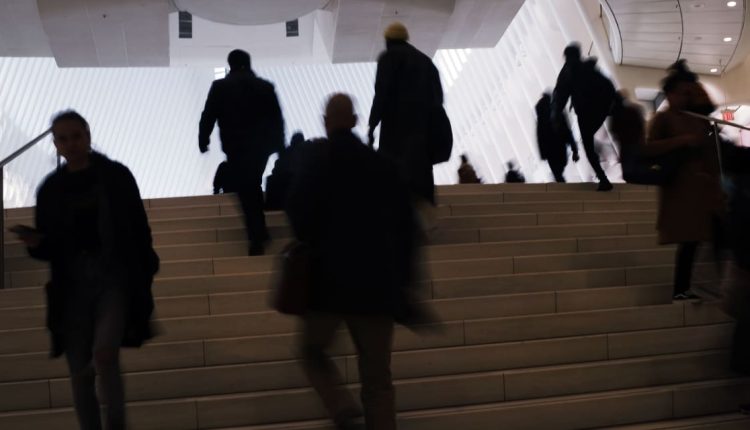Don’t look now, but the September employment report came in roughly in line with what a soft landing for the labor market would look like. Job growth is robust, unemployment is low and wages are moderating.
That could keep the Federal Reserve from raising interest rates in November, even in spite of Friday’s eye-popping headline growth figure.
The U.S. economy added 336,000 jobs in September, more than double the level economists had expected and underscoring just how much strength remains in the labor market despite the Fed’s campaign to cool things down. Job growth for both July and August was also revised upward, showing a combined 119,000 more jobs had been created than previously reported.
Despite the overwhelming strength, however, September’s data reflected notable cooling in an area on which the Fed has been most focused: wages. Average hourly earnings rose 0.2% in September, coming in 0.1 percentage point below expectations and matching the pace set in August. That was the mildest monthly gain in earnings in nearly a year and a half, since February 2022, and it brings wages down to their slowest annual growth rate in more than two years, since June 2021.
Still, as of Friday morning, investors appeared to be focusing on the likelihood that the strong increase in payrolls will outweigh the slowing growth in pay as the Fed makes its final calls on interest rates for 2023. Investors were pricing in a 31% chance of a quarter-point rate hike next month, according to the CME FedWatch tool, up from a 20% chance the day before.
But the cool-down in wages is just as notable as the jump in job growth. It should partly, if not entirely, offset concern that the labor market remains too hot to handle.
“Aside from the payrolls figures…this employment report was indicative of a labor market that is coming into better balance,” wrote Paul Ashworth, chief North America economist with Capital Economics. “With wage growth and price inflation rapidly fading and the rise in long yields triggering a significant tightening in financial conditions, we still think the Fed is done hiking.”
The case for raising interest rates again would center on the expectation that a stronger labor market will lead to heightened consumer spending, especially as gasoline prices tick back down again. That could keep the economy from tipping into recession, but it could also mean inflation sticks around for longer than the Fed would like.
The economists who believe the central bank can hold rates steady argue that the September figures reflect a balanced labor market that can absorb strong job gains without generating higher wage inflation. The report amounted to what JPMorgan Chase analysts David Kelly and Stephanie Aliaga referred to as “strength without heat.”
“Because of this, it is still a close call as to whether the Fed will feel the need to raise short-term rates one last time in November or December,” they wrote.
The most important factor in whether the central bank looks to raise rates again will be the September consumer price index data, which will be released Oct. 12. A stronger-than-expected print would tip the scales in favor of another quarter-point of tightening.
But even then, the steady slowing in the annual pace of inflation in recent months could be clear enough to keep Fed officials on pause—at least for another month.
Harvard economist Jason Furman on Friday wrote that his first reaction to the employment figures was shock, and his second was nervousness. But upon further reflection, he thought “this could be quite good.”
“We could be in the middle of a sustainable increase in labor supply,” Furman wrote. He wouldn’t price in any greater chance of a rate hike at the Fed’s November meeting, he added, given the slowdown in wage growth.
A number of industries saw strength in September, with leisure and hospitality and government employment leading the way. Government hiring accounted for all of the revised strength in July and August, economist Peter Boockvar noted, while the private sector saw job growth revised down by 12,000 for the same two months.
The labor-force participation rate for workers in their prime working years, which is already well above prepandemic levels, held strong at 83.5% on a seasonally adjusted basis.
The September jobs report is the strongest and latest signal of strength in the labor market, which has long been expected to slow under the dual headwinds of high inflation and rising interest rates. But the continued effects of abundant fiscal stimulus in recent years have helped ordinarily rate-sensitive industries, including small businesses and construction firms, continue to hire. The construction sector added another 11,000 jobs in September, and there is no indication of layoffs in sight.
Earlier this week, data on job openings, which are a proxy for labor demand, showed openings jumped in August to 9.6 million, up from 8.9 million the month before.
“This report is the stuff of payroll dreams,” wrote Daleep Singh, chief global economist at PGIM Fixed Income. By itself, Singh added, the numbers shouldn’t “force the Fed into a more hawkish posture.”
But the course of policy will depend on where inflation goes next. “The next CPI report,” Singh wrote, “looms especially large.”
Write to Megan Cassella at [email protected]
Read the full article here

